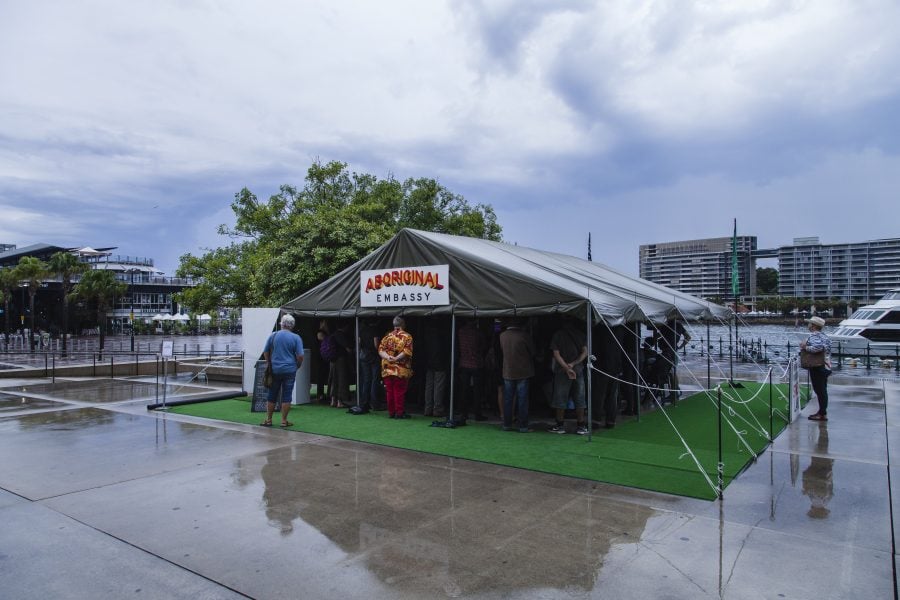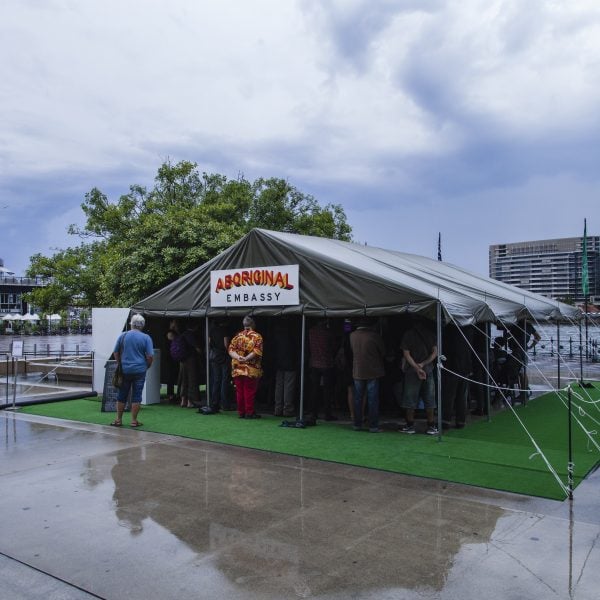Home Participants 20th Biennale of Sydney (2016) Richard Bell
Richard Bell


Richard Bell
Kamilaroi, Kooma, Jiman and Gurang Gurang Peoples Born 1953 in Charleville, Australia Lives and works in Brisbane, Australia

Bell’s activism and his art are fired by the original dispossession suffered by Australia’s Indigenous peoples, and the long-frustrated hope for land justice, which galvanised the Aboriginal Rights Movement in the 1970s. ‘There’s this collective amnesia in this country about what did happen,’ Bell says. ‘That’s basically why I make [art]… I want a revolution in the thinking of Australians.’ [2] Reflecting the ideology of the Black Power Movement and a passionate commitment to change, Bell’s works use a combination of biting satire, provocative gestures and agit-prop activism, demanding a greater awareness of the obligations and debts owed to Australia’s Indigenous populations in the process.
For the 20th Biennale of Sydney, Bell presents a new iteration of Embassy, 2013–ongoing, a restaging and homage based on the original Aboriginal Embassy, established on 26 January 1972 by Redfern-based Aboriginal activists Michael Anderson, Billy Craig, Tony Coorie and Bert Williams. The camp was initially set up under a beach umbrella on the lawns of Parliament House in Canberra, in protest against Australian government policy of the day. In the 44 years since, the Aboriginal Embassy has become a cornerstone of the Indigenous Land Rights Movement, bringing issues of indigenous health, housing and land rights to the forefront of Australian politics.
Bell’s latest version of Embassy serves as the setting for a series of talks by radical political leaders, providing a safe place for thinking, for public debate and conversation. Positioned on the Museum of Contemporary Art Australia forecourt, a harbourside location in the historic Rocks precinct, this significant installation in effect reclaims land that was traditionally owned by the Gadigal people of the Eora Nation, who were displaced soon after the arrival of the First Fleet in 1788. Occupying such a historically loaded, contested site, further amplifies both the symbolic power and ongoing political resonance of Bell’s gesture. As with other works by the artist, he issues a challenge to the viewer, while at the same time providing a space within which to confront, protest, and unsettle assumptions and commonly held ideas – about Aboriginal and non-Aboriginal Australians’ relationships to one another, to their country’s history, and to art in a broader sense.
Selected solo exhibitions include ‘Richard Bell & Emory Douglas All Power to the People: Transcending Borders’, Milani Gallery, Brisbane (2015); ‘Embassy’, Perth Institute of Contemporary Art, Perth (2014); and ‘Imagining Victory’, Artspace, Sydney (2013). Selected group exhibitions include 16th Jakarta Biennale (2015–16); ‘Performa 15’, New York (2015); 8th Asia Pacific Triennial of Contemporary Art, Brisbane (2015–16); and 5th Moscow Biennale of Contemporary Art (2013).
[1] Daniel Browning, ‘Decolonising now: The activism of Richard Bell’, in Richard Bell: Lessons on Etiquette and Manners, Monash University Art Museum, Melbourne, 2013, p. 23. [2] Richard Bell, quoted in ibid.
Richard Bell has often called himself ‘an activist masquerading as an artist’. Aboriginal journalist and radio broadcaster Daniel Browning has suggested that Bell is also ‘a megaphone. But unlike so many other megaphones, his abiding message is not rhetorical, it is revolutionary; he wants to overturn a way of thinking, to decolonise our minds.’ [1] Bell’s deeply held belief in Aboriginal self emancipation has never wavered, and, since the 1990s, he has also been a leading figure in the field of contemporary Australian art, working across painting, performance, video and installation.